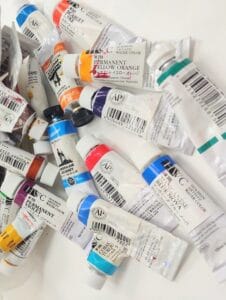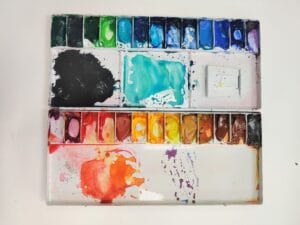As with acrylic and oil painting, you don’t need to buy lots of paints. At least, not when you’re just starting out. So, just keep it simple.
As a beginner, you need red, blue, yellow, black and white. Having these colours in warm and cool versions will offer you a range of options. Warm versions include cadmium red, cadmium yellow and ultramarine blue. Cool colours include magentas, lemon yellow and phthalo blue. Your local art shop should be able to help you find what you need.
My best advice here is to buy quality paint. Learn with fewer, high-quality tubes and you will get better results. Buying good brushes will also make a difference.
You don’t have to go mad: four or five good brushes will give you better results in the long run. There are three essentials: round, flat and angled brushes. I like to have a large Chinese hake brush for applying water for washes and a small rigger brush for fine detail.
Synthetic brushes are cheaper and, some say, easier to use. Natural watercolour brushes are made from animal hair, hold more water and have a softer shape. I will delve deeper into brushes another time.
When I am painting with watercolour, I use two pots of water. One for washing out brushes, which become dirty quickly, and the other for adding clean water to my paint. I also have a small spray bottle on hand to hydrate the paint when it starts to dry out.
Here are a few basic techniques to get started. Wet-on-wet means applying water to your paper and then adding hydrated paint to it whilst it is still wet. This gives a soft base for your painting, often used for skies or water to get the first couple of layers of colour down. Wet-on-dry is used to apply paint to a dry surface and give a more controlled way of working, producing defined strokes of paint.
Dry brushing is a technique using a moist brush to create some texture and broken brushstrokes. This is ideal when trying to simulate foliage, grass, fur or reflections in water. It is also good for creating beautiful skies.
With watercolour it is essential that you work from light to dark, building up layers to create the darkness and depth you need. Remember, you do not use white paint but rather the whiteness of the paper. If you need to preserve a particular area of white and find it difficult to leave that area untouched, there are a few different ways you can do this, using masking fluid being the most popular.
Now play. You will learn much more by using the materials and producing work yourself.
NB, I do not get paid to endorse any people or brands mentioned in my blogs. If you enjoyed this post, please like, share and follow me. Sharing, liking and following raises the algorithms in my favour.
Thank you for your support.
